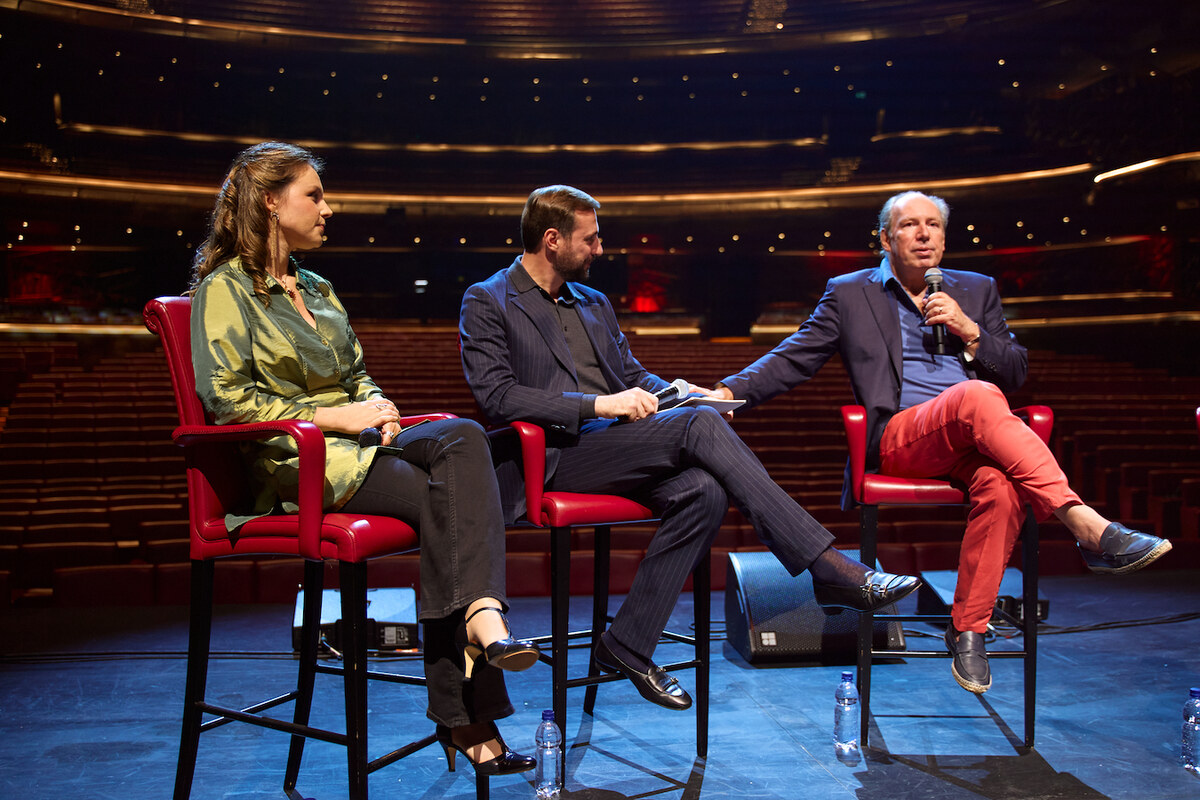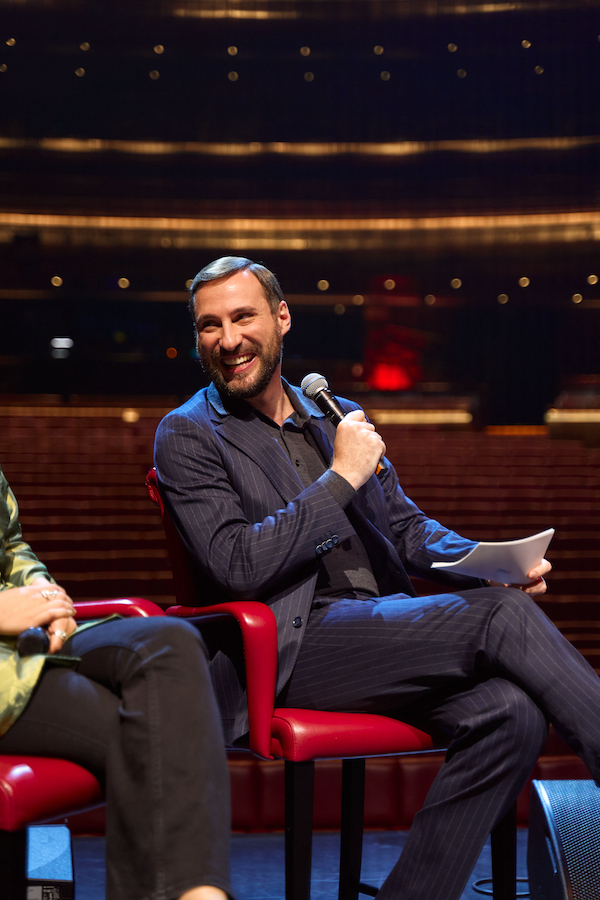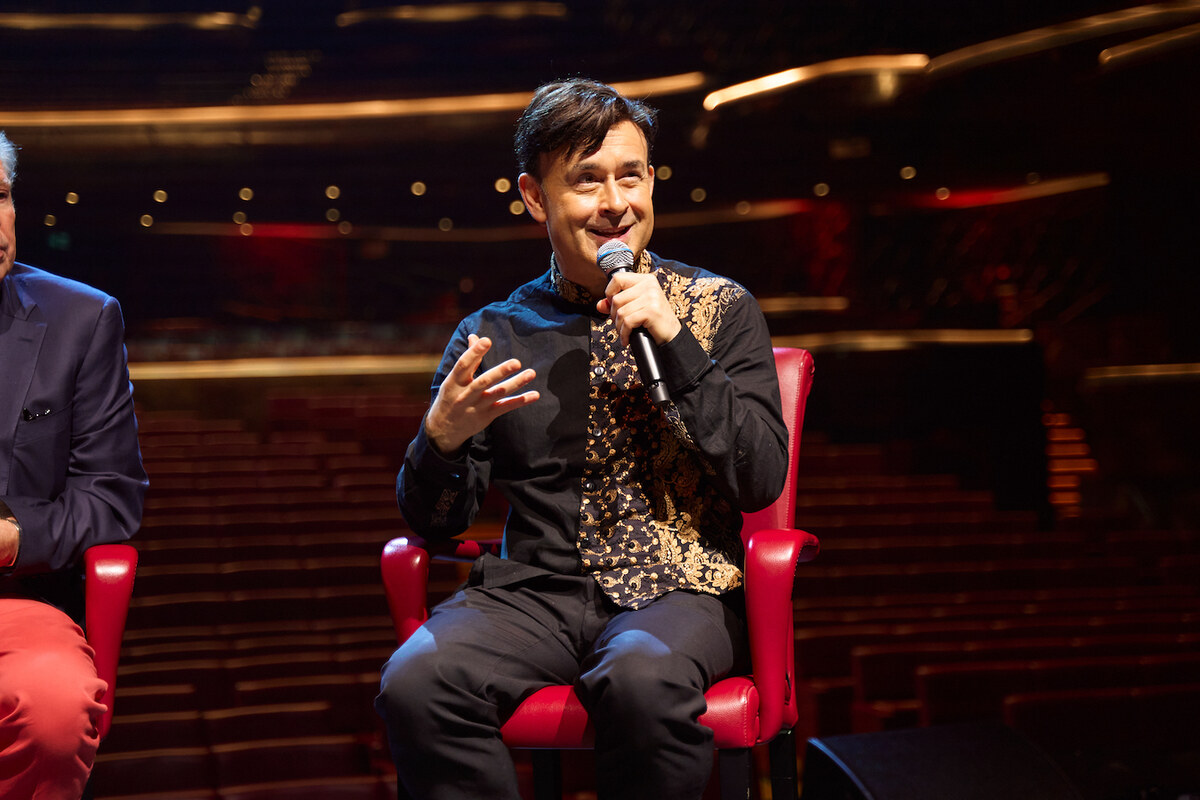AMBOISE, France: The Loire Valley town of Amboise will kick off festivities marking the 500th anniversary of Leonardo da Vinci’s death in style on Thursday, with the French and Italian presidents topping the bill.
The Florentine master who personified the Italian Renaissance was the guest of France’s King Francis I for the final three years of his life before his death in Amboise in 1519.
France’s Emmanuel Macron and Italian President Sergio Mattarella will mark the anniversary with visits to his grave at the royal chateau and the Clos Luce, the sumptuous manor house nearby where Leonardo lived and died.
Among glitterati attending the events will be Italian star architect Renzo Piano and French astronaut Thomas Pesquet.
The joint celebrations come after months of mounting diplomatic tensions between Paris and Rome over the hard-line policies of Italy’s populist government and its support for France’s anti-government “yellow vest” protesters.
In the worst diplomatic crisis between the two countries since World War II, Paris briefly recalled its ambassador from Rome.
Mattarella, staunchly pro-EU like Macron, played an “essential role” in lowering tensions, Macron’s office said.
After some 200 “yellow vests” staged protests in Amboise on Saturday, the town of some 13,000 people was already in virtual lockdown early Wednesday ahead of the presidential visit.
Parking was banned along the riverside motorcade route, with anyone flouting the ban having their vehicle towed away.
Shops, bars and restaurants below the chateau will be shuttered on Thursday.
Emmanuel Honnet, who runs the Cafe des Arts snack bar by the chateau, said the precautions were “understandable... given the terrible social climate and the real terrorist risk.”
But the 51-year-old vented “frustration” that the townspeople would be largely sidelined. “It should be the memory of a lifetime,” he said.
Macron will be the first French president to visit the town since Charles de Gaulle came in 1959.
Francis I, known as the “Sun King of the 16th century,” is widely credited with bringing the Renaissance to France, even if his predecessor Louis XII had begun the process by bringing in architects and artisans from Florence, Milan and Rome.
Leonardo was 64 when he accepted the young Francis I’s invitation, at a time when rivals Michelangelo and Raphael were rising stars.
With Leonardo’s commissions drying up, it came as a great relief and no small vindication for the Tuscan artist, who received a handsome stipend as the “first painter, engineer and architect of the king.”
At the time, Francis I was barely 23, and his ambitious mother Louise of Savoy “knew that Leonardo would be the man who would allow her son to flourish,” Catherine Simon Marion, managing director of the Clos Luce, told AFP.
Leonardo brought with him three of his favorite paintings: the Mona Lisa, the Virgin and Child with Saint Anne, and Saint John the Baptist — all of which today hang in the Louvre museum in Paris.
Italy and France have also sparred over an accord under which Italy will lend several Leonardos to the Louvre in October.
With fewer than 20 Leonardo paintings still in existence, many Italians are resentful that the Louvre possesses five of them, as well as 22 drawings.
During his three years in Amboise, Leonardo organized lavish parties for the court and worked to design an ideal city for Francis at nearby Romorantin — one of the polymath’s many unrealized projects — all while continuing his research.
On Thursday, Macron and Mattarella will also travel to the sprawling chateau of Chambord, whose central double-helix staircase is attributed to Leonardo — though the first stone was not laid until four months after his death.
France, Italy mark 500th anniversary of Leonardo’s death
France, Italy mark 500th anniversary of Leonardo’s death

- The Florentine master who personified the Italian Renaissance was the guest of France’s King Francis I for the final three years of his life before his death in Amboise in 1519
- During his three years in Amboise, Leonardo organized lavish parties for the court and worked to design an ideal city for Francis at nearby Romorantin
Limitless Orchestra marks world premiere at Dubai Opera with show honoring Johann Strauss, Hans Zimmer

DUBAI: Dubai Opera played host to a world premiere this week that reimagines orchestral music for a new generation of music lovers.
“Global Waltzing — from Johann Strauss to Hans Zimmer,” presented by The Limitless Orchestra, took place at the intimate venue at the heart of Dubai on Jan. 10 and 11.
The brainchild of Russian-German violinist and composer Aleksey Igudesman, the orchestra enjoys the distinguished patronage of legendary film composer Hans Zimmer, who also made a special guest appearance on stage on both nights.

Under Igudesman’s innovative “fail forward” approach, “The Limitless Orchestra” breathes new life into the traditional boundaries of symphonic artistry, blending timeless musical techniques with contemporary creativity to deliver an experience that is as daring as it is transformative.
“The world definitely does not need another orchestra, for sure, but I think the world needs this orchestra and other orchestras like it,” Igudesman said ahead of the show.
“The orchestra essentially has not changed, or an orchestra has not changed its format more or less for 150 years. It has become an institution, a very vital cultural institution. But everything that stays the same becomes stagnant and becomes a museum, and then dies eventually, and we do not want an orchestra to die. So, for me, I think launching the ‘Limitless’ orchestra with the help of my great friends is something that I just had to do, because I did not want to have the things that I love so much die, and I wanted to show a possible new way of doing things.”

The show sees the orchestra revitalize the timeless works of Johann Strauss, skillfully blending the cherished compositions of the Austrian king of the waltz with the epic film music of Hollywood legend Zimmer.
Zimmer, displaying his trademark humility, said: “I don’t think there are limitations to classical music. I would hate to go about ruining Bach or Mozart. That’s their music and we can have new music.
“I’m just a peasant of music. I write film music. But the weird thing is that every day I get to go out and hire an orchestra. I get to go out and play in arenas for 20,000 people. So, something is working with what I’m doing. I’m adding instruments to the orchestra, I’m adding playfulness.”

The program will showcase a dazzling fusion of classical and cinematic music through an innovative selection of compositions, including the opening piece, “Emperor Waltz, Sultan Style,” by Igudesman and Tristan Schulze, inspired by Johann Strauss.
Other pieces include “Sherlock Holmes Fantasy,” “From Time to Time — Inception Waltz,” and “The Banker’s Waltz.”
Igudesman, celebrated for his electrifying performances and whimsical approach to classical music, will perform original works and innovative compositions, accompanied by the mesmerizing voice of soprano Ekaterina Shelehova.
Saudi-backed film to screen at International Film Festival Rotterdam

DUBAI: The International Film Festival Rotterdam this week revealed its line-up for the 2025 edition, featuring the Red Sea Film Foundation-supported “Dead Dog” by Lebanese director Sarah Francis.
The film follows Walid and Aida, a husband and wife reunited after his long absence abroad. As they confront the emotional distance between them, secrets come to light, including Aida’s silence about their beloved dog Punto. Set against a backdrop of shifting dynamics and unspoken truths, “Dead Dog” explores themes of estrangement, trust, and the complexities of marriage.
The festival is set to take place from Jan. 30 to Feb. 9.
Netflix unveils season 2 trailer for ‘Mo’

DUBAI: Netflix this week released the trailer for the highly anticipated second season of Palestinian-American comedian Mohammed Amer’s award-winning series “Mo,” announcing its debut on Jan. 30.
The new trailer showcases the show’s signature humor and heartfelt moments as Mo Najjar, played by Amer, continues to navigate life as a Palestinian refugee in the US.
In season 2, he finds himself stuck on the other side of the border, desperately trying to make it back to Houston in time for his family’s important asylum hearing. With no passport and few options, he faces a series of unexpected challenges, including a new rival who jeopardizes his relationship with Maria and his signature falafel taco recipe.
Coldplay lights up chilly Abu Dhabi with visual and auditory spectacle

- Band began 4-day UAE concert series on Thursday
- Show is part of their Music of the Spheres World Tour
DUBAI: Grammy Award-winning band Coldplay lit up a chilly Abu Dhabi with a visual and auditory spectacle on Thursday at Zayed Sports City Stadium, for the first of their four-day concert series that is a part of their Music of the Spheres World Tour.
The setlist featured crowd favorites including “All the Love,” “Yellow,” “Hymn for the Weekend,” “Paradise,” “The Scientist,” “Clocks,” and “A Sky Full of Stars.”
Adoring fans wore glowing wristbands that pulsed in sync with the music. There were bursts of confetti, large illuminated planets suspended throughout the stadium, and balloons floating across the crowd.
Coldplay engaged with the audience, including having a couple reveal their baby’s gender, drawing cheers from the crowd.
Frontman Chris Martin charmed the audience further by speaking in Arabic. “Assalamu alaikum, wa masa’ al khair. Shukran jazeelan,” he said, translating to “Peace to you, and good evening. Thank you very much.”
Before Coldplay’s set, Chilean-Palestinian singer Elyanna warmed up the crowd with a captivating performance, singing hits including “Ganeni” and “Mama Eh.”
Later, she joined Coldplay on stage to perform their collaborative track, “We Pray.”
The concert ended with a breathtaking fireworks display.
Coldplay will perform in the UAE capital on Jan. 11, 12 and 14.
Highlights from the traveling ‘Art of the Kingdom’ exhibition

- The show, which is on display in Rio de Janeiro until Jan. 12, features work by 17 contemporary Saudi-based artists
RIYADH: “Art of the Kingdom” is perhaps the most significant exhibition so far for Saudi contemporary artists. It has already been on show in Brazil’s capital city for three months, and will soon move to Riyadh, before heading to China.
It features works by 17 Saudi, or Saudi-based, artists — Ayman Yossri Daydban, Ahmed Mater, Emy Kat (Mohamed Alkhatib), Ayman Zedani, Shadia Alem, Nasser Al-Salem, Manal AlDowayan, Lina Gazzaz, Muhannad Shono, Sarah Brahim, Daniah Alsaleh, Faisal Samra, Filwa Nazer, Moath Alofi, Ahaad Alamoudi, Sarah Abuabdallah, and Ghada Al-Hassan — and, as the press release states, “offers a unique opportunity to explore the ways in which Saudi contemporary art contributes to shaping new cultural narratives.”
The press release also states: “Two main themes emerge from the exhibition … The first is the desert as a definition of space, infinity, and life; the second is the singularity of cultural tradition, and the evolution of a unique visual culture, shaped by diverse pasts and presents.”
Here are just a few of the artworks that make up the exhibition, the theme of which is “Poetic Illuminations.”
Nasser Al-Salem
‘Arabi/Gharbi’
The Makkah-born artist’s work, according to the exhibition brochure, “challenges the traditional boundaries of Islamic calligraphy by re-contextualizing it through mixed media, minimalist approaches, and architectural methods.” This piece, the title of which translates to ‘Arab/Foreigner’ is made up of neon lighting that presents both words simultaneously: a single illuminated (or not illuminated) dot allows it to switch between the two — when lit, it says ‘Gharbi,’ when unlit it reads “Arabi” — thus highlighting the minor differences that help form our images or ourselves. It is used as both the first and last piece in the exhibition, because, according to curator Diana Wechsler, “it installs a border between the contemporary Saudi world and the cultural horizon of the public. The journey through the exhibition shows, piece by piece … different aspects of this fascinating culture in which past and present, traditions and changes are involved. Arriving at the end of this journey and finding again the twinkling neon of Nasser Al-Salem, I like to imagine that the public will see it differently; that the experience of the journey has been able to broaden their horizons.”

Ahmed Mater
‘X-Ray Illumination Diptych 1’
Mater is one of the most internationally famous Saudi contemporary artists — last summer he was the subject of a mid-career retrospective at Christie’s in London. This work comes from his “Illuminations” series, which, according to the artist’s website, blends “the past, represented by traditional Islamic arts, with the present, through the innovations of modern medicine.”
It continues: “Faith and science are brought together — two subjects that are often treated as essentially separate and full of tense contradictions.” It is perhaps no surprise that the work of Mater — a doctor and an artist — should tackle these contradictions.
In a brief essay about the series, Linda Komaroff, of the Los Angeles County Museum of Art, writes: “What could be more intimate than literally to see inside another individual? This is most eloquently expressed in (Mater’s) great diptychs in which a traditional type of richly illuminated double page composition frames two X-rays set face to face; the skeletal images suggest some elemental form of humanity, stripped of the skin, hair, eyes and clothes that differentiate as well as separate us.”

Sarah Brahim
‘Soft Machines/Far Away Engines’
This work by visual and performance artist Sarah Brahim was originally commissioned for the first Diriyah Contemporary Biennale in 2021. The screens show individuals moving and embracing. Small gestures, Brahim told Arab News in July 2022, are “amplified through repetition and layering, conjuring up multifaceted images of beauty.” Her work in general, according to the show brochure, “is a response to and reflection on how we can heal both internally and externally, and how art and culture can serve as a vehicle for this movement.”

Ayman Zedani
‘The Return of the Old Ones’
“The construction and consumption of nature in the Gulf are central” to Zedani’s “exploration process,” the show brochure states. “His projects serve as platforms inviting the public to observe the symbiosis between human and non-human elements.” This experimental film offers “a poetic perspective from a non-human entity,” according to the artist’s website, “weaving factual information with a science fiction narrative to explore the story of oil through the life, death, and resurrection of ancient giant fungi known as Prototaxites,” remnants of which “have only been found in a few places in the world, including Saudi Arabia and the US.” The story, “reminds us that fossil fuels comes from ancient life forms that have been crushed down into raw black energy.”

Shadia Alem
‘Negatives, no more’
Alem’s installation consists of thousands of photo negatives hand-stitched together and covering 20 years of her and her sister’s life from 1985-2005, as well as larger DVD images. It symbolizes the difficulty of being both an artist and a woman in the Kingdom at that time. “In the world’s conscience, we remained indifferently invisible and when accidentally subjected to the media’s light, we were outlined as passive, veiled/ negatives without prints,” Alem writes on her website. “Nonetheless, we were there all along, actively creating, struggling, weaving our lives … Nowadays, we reached a point in our history where all is changed … we rode the tide casting away the darkness overshadowing our identities.”













